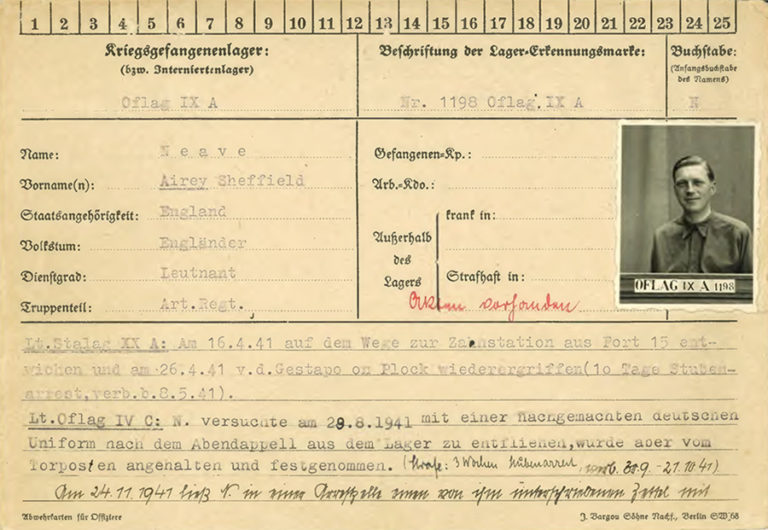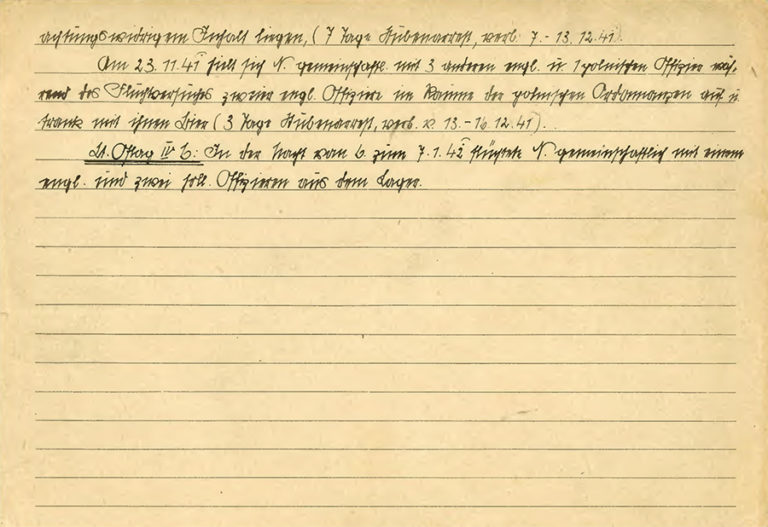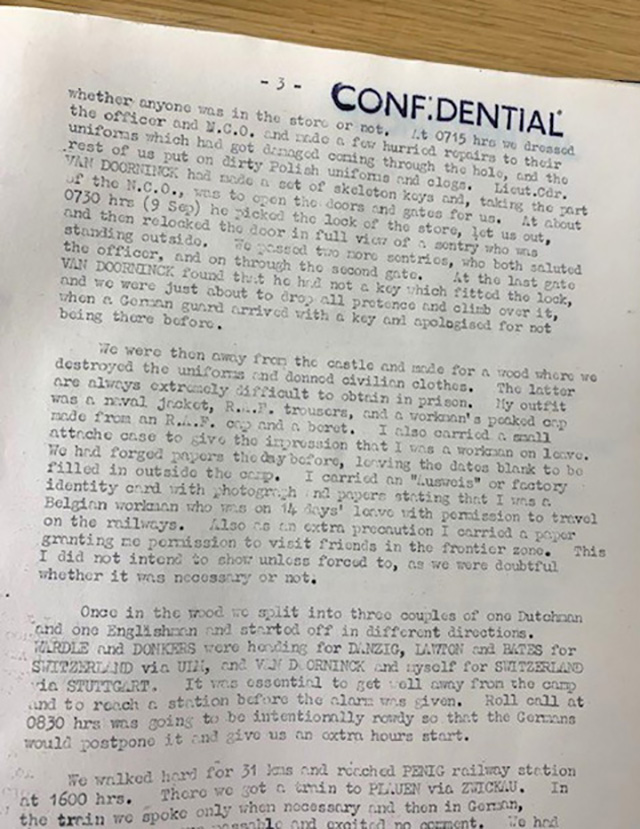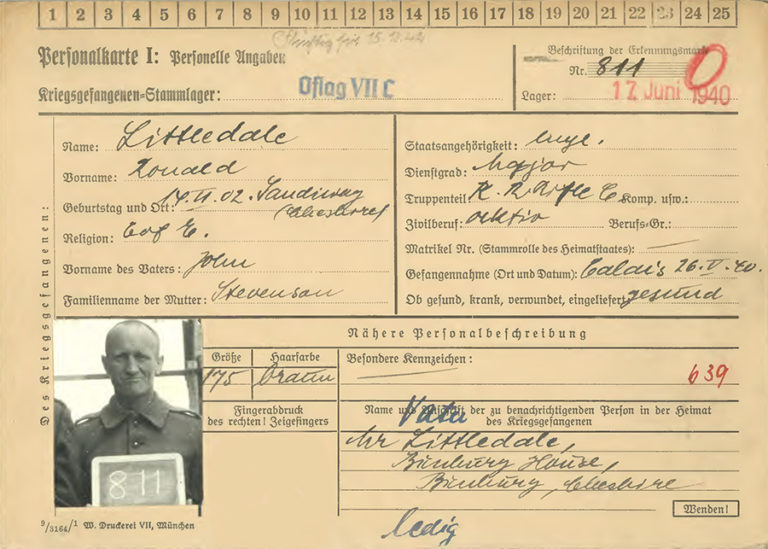I was fortunate enough to visit Colditz Castle, 25 miles south-east of Leipzig, in July last year when on holiday in Germany. It has had a chequered history over the past 500 years and has been used for a variety of purposes including a hunting lodge, workhouse, mental hospital, sanatorium, political prison and hospital. But, between 1939 and 1945, it was famously used as a prisoner of war camp to house British and Allied Officers who had previously escaped from other camps, or were deemed to be a high security risk.

The location of Colditz Castle, situated on a steep conical hill above the River Mulde and surrounded by barbed wire and under the watchful eyes of armed sentries, made the camp difficult, but not impossible, to escape from. It was known officially as Oflag IV-C. ‘Oflag’ indicating a camp for Officers and ‘IV-C’ the designation of its location in Colditz. It is now a tourist attraction and I signed up for a guided tour of the castle and grounds, learning more about its time as the Escapers’ Gaol, which spurred me on to write this blog, using official records at The National Archives.
The castle was home to some 400 officers for much of the war yet, despite the security measures in place, there were a number of significant attempts at escape made. Initially, in the autumn of 1940, the camp was occupied by some 70 officers coming from the British Army, Royal Navy and Royal Air Force. The numbers increased sharply in 1943 when a further 65 army officers arrived with a contingent of other nationalities, including American, French, Dutch and Polish.
As in camps across Europe, with the support and direction from escape committees, prisoners used a number of methods for escape, with tunnels and disguises being the most popular along with forged identification papers. It is estimated that over 4,000 British and Allied personnel escaped or evaded capture across Europe during the Second World War. At Colditz, there were more than 30 successful escape attempts including ten by British and Commonwealth Officers.
Newly released documents at The National Archives show the three remarkable and successful escape attempts made by three British-born Officers – Flight Lieutenant Hedley S Fowler, Lieutenant Colonel Ronald Bolton Littledale, and British Army Lieutenant Airey M S Neave. These records, in the series WO 416, consist of British and Allied prisoner of war records created by the Germans and captured by the Allied forces when the camps were liberated at the end of the war. They document the German accounts of the escapes and create a fascinating comparison to the subsequent MI9 escape reports in series WO 208, which were compiled when the individuals made it safely to neutral and Allied territory.
Lieutenant Airey Neave
Lieutenant Airey Neave was just one of the tens of thousands of British and Commonwealth personnel captured at French ports following the fall of France in May 1940. Wounded and captured at Calais, he was taken to Stalag XXA near Thorn in Poland and managed to escape with a fellow prisoner in April 1941. Upon capture, he was transferred to Colditz.


Translation of the German account of Neave’s escapes from Stalag XXA (Thorn) on 16 April 1941 and later from Oflag IVC (Colditz) on 7 January 1942:
| POW camp (or internment camp) | Camp identity | First letter of surname |
| Oflag IX-A | No 1198 Oflag IX-A | N |
| Name: Neave | Prisoner | |
| First name(s): Airey Sheffield | Work placements | |
| Nationality: England | ||
| Race: English | Periods outside the camp | |
| Rank: Lieutenant | either ill | |
| Military unit: Artillery Regiment | Or punishment |
According to Stalag XXA: on 16 April 1941, N disappeared on route to the dentist from Fort 15 and on 26 April 1941, he was recaptured by the Gestapo at Plock. (10 days confined arrest completed on 8 May 1941).
According to Oflag IVC on 29 August 1941, N tried to escape from the camp after evening roll call, using a fake German uniform, but was stopped at the gate post and seized. Punishment: three weeks close confinement 30 Sept to 21 Oct 1941.
On 24 November 1941, N was put in a punishment cell after being found with a (home made) chitty and behaving against the rules. (7 days confined arrest, 7-13 Dec 1941).
On 23 November 1941, N and three other English officers and one (Polish) officer (held up someone) to enable an English officer to make an escape attempt near the (Polish) orderly office. (3 days confined arrest 13-16 Dec 1941).
According to Oflag IVC, on the night of 6 or 7 January 1942, N escaped from the camp together with an English and two (Dutch) officers.
All of Neave’s escapes and attempts to escape are borne out by the MI9 escape reports in the series WO 208 – the four officers escaped in pairs, one English and one (German speaking) Dutch Officer. Neave and a Dutch officer, Lieutenant Luteyn, were the first of the two pairs to leave and successfully reached Switzerland. The other pair was recaptured in Ulm.


Neave went on to work as an intelligence agent for MI9 and served with the International Military Tribunal at the Nuremberg trials in 1946. Then, from 1950, he served as a British MP before his untimely death in March 1979 when a car bomb exploded as he drove out of the Palace of Westminster car park.
Lieutenant Hedley Fowler
Flight Lieutenant Hedley Fowler’s plane was shot down in May 1940. As with Neave, Fowler successfully escaped from his first camp, Stalag Luft 1, near Barth, a German coastal town off the Baltic Sea. Arrested at the docks, he was transferred to Colditz in December 1941.
His escape from Colditz took place on 9 September 1942. He and five other prisoners were to leave the castle disguised as a work party removing clothes from the clothing store, four to be dressed as Polish orderlies, one disguised as a German officer, the other as a German soldier. All went well as the six escapers entered the office during the previous evening and opened up the tunnel. However, around midnight there was an alarm and the Germans searched the castle. With luck, the office door had been relocked and this satisfied the soldiers that nobody had entered the office. After entering the clothing store, the tunnel was sealed to allow later use (it was discovered the following day during the search for the missing officers). At 07.30 the escape party left the store, timed to be shortly after the change of the German sentries – the idea being that the new sentries would be unaware of who had already entered the store. Outside the camp the party changed into civilian clothes and separated – Fowler travelling on foot to Penig (about 31 kilometres) and from there by train to Plauen via Zwickau.
They caught the train to Stuttgart where they stayed overnight in a small hotel. The following morning they caught a train to Tuttlingen and walked to the Swiss border. On the way to the border they were stopped by an SS policeman, but their forged papers were sufficient to pass inspection. They crossed into Switzerland at 01.30 on 13 September 1942, and were taken to the British legation at Bern. The other four escapers were recaptured close to Colditz.
On reaching the UK, Fowler was promoted to squadron leader and posted to the Armament Test Squadron at Boscombe Down to act as a test pilot. He was killed during an air test flying a Hawker Typhoon on 26 March 1944, and is buried at Durrington Cemetery.


Lieutenant Colonel Ronald Bolton Littledale
Lieutenant Colonel Ronald Bolton Littledale was also captured at Calais and escaped from his first camp, Stalag XXI-A in Poznan in Poland. Upon recapture, he was transferred to Colditz in June 1942 where he teamed up with Lieutenant Commander Billie Stephens. They hatched a plan to escape through a kitchen window and then make a dash to freedom, through the courtyard and through the walls across the dry moat to the final row of barbed wire.
Their escape, on 14 October 1942, took place with two other officers. Other prisoners of war, including Douglas Bader, distracted the guards and used signaling devices to help the escapers. Unable to unpick a lock, the prisoners escaped via a cellar which connected to ground on the far side of the camp. It took them over eight hours to escape from the grounds. Upon escape, the two parties separated. Littledale and Stephens, with forged papers, caught the morning train from Rocklitz to Chemitz. It took them a further four days to reach safety in Switzerland.


Littledale returned to Britain in 1943. As with Neave and Fowler, for his escapes and actions while in activity he was awarded gallantry medals. He was killed in action on 1 September 1944, commanding the second Battalion of the King’s Royal Rifle Corps, and is buried at Airaines Cemetery in France.
Red Cross inspection reports identified Oflag IV-C as a problem camp with inadequate sanitary and harsh confinement measures.

In May 1943 it was decided that Colditz should house only Americans and British and Commonwealth prisoners of war, and in August 1944 it received its first Americans. Less than eight months later Oflag IV-C was captured by American soldiers from 1st US Army.
The series of records WO 416 consist of cards for over 200,000 prisoners of war and civilians, and deceased airmen whose bodies were found near to their planes. They are currently being catalogued by name by volunteers. Records of some 125,000 captives with surnames A-L can now be fully searched in our catalogue, Discovery, and you can see when we expect to fully catalogue the remaining pieces by looking at this page, under arrangement.
Unfortunately COVID-19 has significantly delayed progress on the project, which requires consultation of original documents at Kew. That said, I’m delighted to say that the project has now restarted but, because of social distancing, it will take longer to complete.
Find out more
Find out more about Second World War internment and POW records at our free exhibition Great Escapes: Remarkable Second World War Captives. Opening Friday 2 February 2024, Great Escapes explores the human spirit of hope and resilience during times of captivity, revealing both iconic and under-told stories of prisoners of war and civilian internees during the Second World War.
We’ve also scheduled a season of special events to accompany the exhibition that are available to book now.

Neave was the author of a number of books concerning his wartime careers including ‘Saturday at MI9’ referring to his nomme de guerre at the organisation.
Airey Neave was also involved in getting Nazi persecution claims investigated in the 1960s (see series FO 950 at TNA) whilst he was a Member of Parliament.
Hello,
It was interesting to read that you have recently visited coldtz as I have wanted to visit Colditz castle myself for some years now. I
I have read most of the prisoners memoirs, most recently Peter
Tunstall very interesting recollections. As most of the prisoners have sadly all passed now I wondered who if anybody was still running a Colditz association? I know Harry Lockwood ran it till his death in 2007. It seems a shame if no one is encouraging continued interest in a remarkable group of men
Thank you
Bob Lee
The Colditz Association is now the Colditz Society. Sadly the last surviving British pow and Society member Corran Purton died in 2018. We still hold two meetings a year at the Union Jack Club London. We have a private group on Facebook. Please look us up.